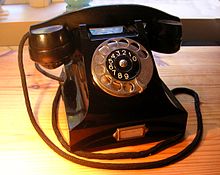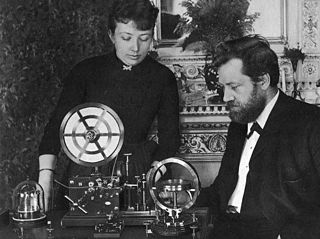
The Bakelite phone (bakelittelefon) officially known as Ericsson DBH 1001, and later as M33, N1020, and ED 702, was a Swedish line of telephones made from the polymer Bakelite and produced for over thirty years between 1931 and 1962. [1] [2]

The Bakelite phone (bakelittelefon) officially known as Ericsson DBH 1001, and later as M33, N1020, and ED 702, was a Swedish line of telephones made from the polymer Bakelite and produced for over thirty years between 1931 and 1962. [1] [2]
The Ericsson DBH 1001 of 1931 was a collaborative project between the Elektrisk Bureau in Oslo, Televerket (Sweden) and Lars Magnus Ericsson (1846–1926). It was designed by Norwegian electrical engineer Johan Christian Bjerknes (1889-1983) and Norwegian artist and designer Jean Heiberg (1884–1976). It was the first Bakelite phone with integral cradle, dial and ringer, and was very modern for its time. [3] [4] [5]
Until the early 1930s, the housing of the Swedish phone models was made from pressed steel. Material change from steel to Bakelite brought new opportunities in design, while also reducing the production time for the housing. The Bakelite phone was not only compact but also light at just below 3 kg (6.6 lb), and could be grasped by one hand. The device with its simple, curved angular design became an instant hit with the industry as well as the consumers, and was highly influential. In most of Europe, it was known as the Swedish type of telephone. [6]
Already in the mid 1930s, Ericsson showed a white Bakelite phone in advertisements, often in the hands of a young woman. However, this model seems never to have been offered to the public. At the 1939 World Fair in New York City, Ericsson showed a transparent variant made of acrylic and diakon plastic.
The standard color of the phone was black, but there were also variants in drab brown, red, and green. The process of using Bakelite did not permit the production of bright colors. The device was manufactured from 1933 in a smaller format, and from 1947 redesigned with softer, more rounded edges as the model designated M50. It was also offered in white melamine resin. The metal dial rotor was replaced with a plastic version, and a spiral cord became standard. [7]
During 1950, Ericsson also experimented with a keypad version, instead of the rotary dial, but it would take another ten years before they became standard in Swedish phones. In 1962, the Bakelite Phone was replaced by the Ericsson Dialog model.

Telefonaktiebolaget LM Ericsson, commonly known as Ericsson, is a Swedish multinational networking and telecommunications company headquartered in Stockholm, Sweden. The company sells infrastructure, software, and services in information and communications technology for telecommunications service providers and enterprises, including, among others, 3G, 4G, and 5G equipment, and Internet Protocol (IP) and optical transport systems. The company employs around 100,000 people and operates in more than 180 countries. Ericsson has over 57,000 granted patents.

Lars Magnus Ericsson was a Swedish inventor, entrepreneur and founder of telephone equipment manufacturer Ericsson.

A rotary dial is a component of a telephone or a telephone switchboard that implements a signaling technology in telecommunications known as pulse dialing. It is used when initiating a telephone call to transmit the destination telephone number to a telephone exchange.

A telephone, colloquially referred to as a phone, is a telecommunications device that permits two or more users to conduct a conversation when they are too far apart to be easily heard directly. A telephone converts sound, typically and most efficiently the human voice, into electronic signals that are transmitted via cables and other communication channels to another telephone which reproduces the sound to the receiving user. The term is derived from Ancient Greek: τῆλε, romanized: tēle, lit. 'far' and φωνή, together meaning distant voice.

The Trimline telephone is a series of telephones that was produced by Western Electric, the manufacturing unit of the Bell System. These telephones were first introduced in 1965 and are formally referred to as the No. 220 Hand Telephone Sets. The Trimline was designed by Henry Dreyfuss Associates under the project direction of Donald Genaro; the firm had produced the previous post-war desktop telephone types for the American Telephone & Telegraph Company.

The Ericofon is a one-piece plastic telephone created by the Ericsson Company of Sweden and marketed through the second half of the 20th century. It was the first commercially marketed telephone to incorporate the dial and handset into a single unit. Because of its styling and its influence on future telephone design, the Ericofon is considered one of the most significant industrial designs of the 20th century by Phaidon. It is in the collection of the Museum of Modern Art in New York City. In Sweden, the Ericofon is known as the cobra telephone for its resemblance to the hooded snake of the same name.

The Western Electric model 500 telephone series was the standard domestic desk telephone set issued by the Bell System in North America from 1950 through the 1984 Bell System divestiture. The successor to the model 302 telephone, the model 500's modular construction compared to previous types simplified manufacture and repair and facilitated a large number of variants with added features. Touch-tone service was introduced to residential customers in 1963 with the model 1500 telephone, which had a push-button pad for the ten digits. The model 2500 telephone, introduced in 1968, added the * (asterisk) and # (pound) keys.

The model 302 telephone is a desk set telephone that was manufactured in the United States by Western Electric from 1937 until 1955, and by Northern Electric in Canada until the late 1950s, until well after the introduction of the 500-type telephone in 1949. The sets were routinely refurbished into the 1960s. It was one of the most widely used American combined telephone sets to include the ringer and network circuitry in the same telephone housing.

A clamshell design is a kind of form factor for electronic devices in the shape of a clam shell. Mobile phones, handheld game consoles, and especially laptops, are often designed like clamshells. Clamshell devices are usually made of two sections connected by a hinge, each section containing either a flat panel display or an alphanumeric keyboard/keypad, which can fold into contact together like a bivalve shell.

Ericsson Dialog is a Swedish telephone model by Ericsson, released 1964. Millions of the model were sold and it retained its place in homes well into the 1990s. The Ericsson company presented King Carl XVI Gustaf of Sweden with a unique handmade Dialog telephone on his 40th birthday.

The Trimphone is a model of telephone designed in the early 1960s in the UK, the first prototypes appearing in 1965. It was positioned as a more fashionable alternative to the standard telephones available from the Post Office Telephones, the nationalised predecessor to British Telecom. The name is an acronym standing for Tone Ring Illuminator Model, referring to the then innovative electronic ringer and the illuminated dial. The luminous dial or betalight contained the mildly radioactive element tritium, which later caused some concern about safety. In June 1991, the United Kingdom Atomic Energy Authority at Harwell was fined £3,000 by Wantage Magistrates Court for accumulating radioactive waste, having collected several thousand Trimphone luminous dials in a skip.

The Grillo telephone is a 1960s flip phone telephone from Italy. It was designed by Richard Sapper and Marco Zanuso, and introduced in 1967. The "Grillo" was manufactured by Italtel, a subsidiary former state-owned telecommunications company SIP, and remained in production until 1979. It was a popular and iconic symbol of 1960s Italian design.

A push-button telephone is a telephone that has buttons or keys for dialing a telephone number, in contrast to a rotary dial used in earlier telephones.

Jean Hjalmar Dahl Heiberg was a Norwegian painter, sculptor, designer and art professor.

Carl Richard Nyberg was a Swedish inventor and industrialist. Nyberg was a pioneer in mechanical engineering. He received a patent for a blow lamp and was an aviation pioneer.

Gábor Kornél Tolnai was a Hungarian-Swedish engineer and inventor. He is best known for his inventions and patents for spinning machines, devices for the Swedish National Defense and several types of tape recorders.

Events from the year 1846 in Sweden

Hilda Carolina Ericsson was a Swedish entrepreneur. She founded the telecommunications company Ericsson together with her husband Lars Magnus Ericsson. She was involved in testing inventions and developing new products. In her husband's absence, she took over the company's management.
Ragnhild Laila Lillemor Ohlgren, born Andersson was a Swedish telecommunications engineer who is seen as the developer of mobile telephony together with Östen Mäkitalo, both engineers at Telia. In particular, she successfully introduced storage of the telephone number to be dialed in the phone's microprocessor so that connection could be achieved by pressing the call button. This avoided transmission breakages caused by obstacles such as trees during more lengthy traditional dialing. The approach was subsequently adopted worldwide. For her efforts, in 2009 she became the first woman to be awarded the Polhem Prize for technical innovation.